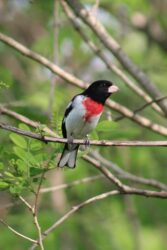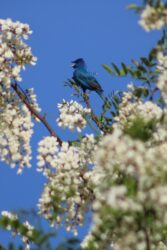By volunteer

In 2006, in an effort to raise awareness of the need for conservation and the wonders of bird migration, the U.N. declared an annual World Migratory Bird Day. Held on the second weekend in May, it is an opportunity for the world community to come together to celebrate and protect migratory birds and their habitats. Last year nearly 80 nations took part. It is not an official holiday but we can celebrate it anyway.
Worldwide, there are about 10,000 different species of birds. It is estimated that somewhere around 40% of them migrate annually. These birds travel hundreds and even thousands of miles every year, and in the process, connect every country and continent on earth. They exhibit levels of endurance humans can only dream of. A recent visitor to Bernheim saw our ‘Migration Station’ map and was amazed to learn one of our ‘Migration Superstars’ could be seen at her home in the Phillipines for only a couple of weeks in April and May.
In North America there are about 1,000 species of birds, with about 400 that migrate. At Bernheim Forest, you can find a fair number of these migrating birds. Over 200 bird species have been seen and heard in the forest. All but about 30 migrate to, or through, the forests more than 16,000 acres.

Several species that have been with us all winter have started moving back north to their summer breeding grounds. We will be saying goodbye to White-Throated Sparrows, Pine Siskins, Juncoes, and many others. As they have been heading into the distance, others have been arriving to take their place. Purple Martins started arriving near the end of March and are already busy with nesting. Barn Swallows are arriving daily. Indigo Buntings are making their presence known. Many others are arriving and starting their breeding activities as well.
Migration season also offers the careful observer the opportunity to see and study birds that are only passing through. One my personal favorites among non-resident migratory birds is the Rose-breasted Grosbeak. Every year my wife and I can mark our calendars by their arrival at our feeders. In spring, as they pass through our area, the males are already in full breeding plumage and looking sharp.
Warblers have been described as the ‘butterflies’ of the bird world. This is because of the wide variety of species, each with unique plumage, and their constant flitting about in search of food. Sadly for us, most warblers will spend the summer farther north of us so migration season is our only chance to see them
For those that can’t travel, or have no place to watch, Bernheim Forest is the place to be. There are a number of places where a person can just sit and watch a variety of birds go about the business of being birds. If you prefer, you can take a hike one of the many trails and seek out the birds there. If you need a break from the heat, visit the Wildlife Viewing Room in the Education Center. It is a comfortable, climate-controlled environment that allows for the close observation of several bird species.
The second weekend of May is World Migratory Bird Day. Come out to Bernheim Forest. You can learn more about some migration superstars while you connect with nature and the world birding community at the same time. It is not an official holiday but we can celebrate it anyway.
–Jim Scout, Volunteer Naturalist

